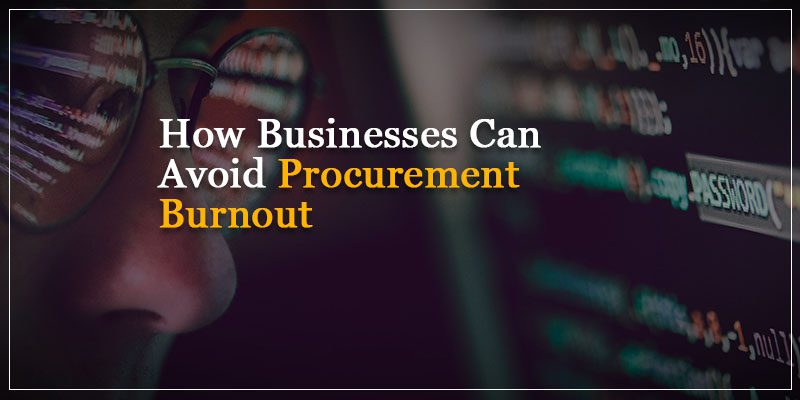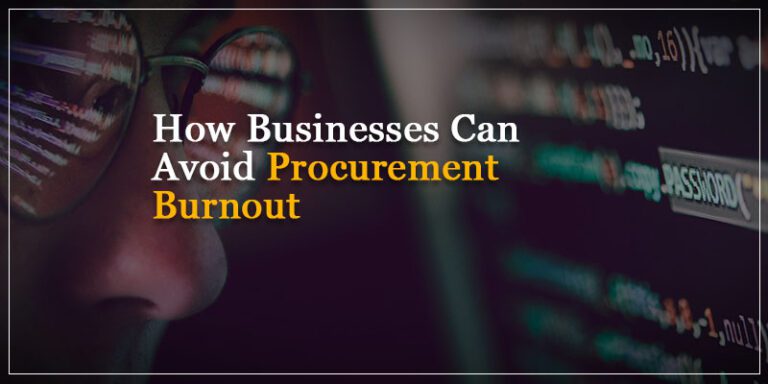How Businesses Can Avoid Procurement Burnout


As part of Solutions Review’s Contributed Content Series—a collection of contributed articles written by our enterprise tech thought leader community—Jack Macfarlane, the Founder and CEO of DeepStream, explains how burnout is affecting the procurement industry and offers some suggestions companies can use to address it.
 Workplace burnout has become more discussed and understood over recent years as businesses realize the value of protecting and prioritizing employee wellbeing. Burnout has become what some consider a modern workplace epidemic, and procurement professionals have not escaped this worrying trend. Since the pandemic, sourcing professionals have been swept up in a perfect storm of global volatility, geopolitical disruption, and inflation, meaning they are facing extra pressure and complexities while carrying out their roles.
Workplace burnout has become more discussed and understood over recent years as businesses realize the value of protecting and prioritizing employee wellbeing. Burnout has become what some consider a modern workplace epidemic, and procurement professionals have not escaped this worrying trend. Since the pandemic, sourcing professionals have been swept up in a perfect storm of global volatility, geopolitical disruption, and inflation, meaning they are facing extra pressure and complexities while carrying out their roles.
According to a recent survey, over 86 percent of procurement professionals saw an increase in their workload in 2022, while over half reported they had fewer resources to act on it. So, how can businesses take steps to avoid procurement burnout before it impacts their workforce and bottom line?
Understanding Workplace Burnout
Burnout is recognized by the World Health Organisation as an ‘occupational phenomenon.’ A recent study found as many as 88 percent of workers experience it at some point in their careers. Common symptoms include difficulty concentrating, lack of motivation, increased cynicism, irritability, and dissatisfaction with your job. If left unaddressed, burnout can lead to excessive stress, insomnia, depression, alcohol and substance misuse, and health conditions such as heart disease, type 2 diabetes, and high blood pressure.
Despite its prevalence and seriousness, burnout continues to be misunderstood and stigmatized in the workplace. Both employees and employers may not be equipped to spot the signs of burnout, and therefore, issues can quickly escalate, affecting productivity, well-being, and morale.
Why is There a Burnout Epidemic in Procurement?
Procurement plays a critical role in solving today’s most pressing business problems and can be a highly rewarding career. But in today’s climate, where businesses face rising costs and supply chain complexities, the responsibility placed on the shoulders of procurement professionals is ever-growing and expanding. They are expected to protect margins, contain cost escalation, and capture new market opportunities at a time of volatility and inflationary pressures.
Slow digital transformation is adding to the pressure felt by procurement teams to deliver what is expected of them with limited resources. Legacy IT systems and processes endure within the sector, placing a strain on productivity and morale. It can also suppress efficiency, transparency, and data accuracy. Low staff retention is also affecting the sector. According to a recent survey of supply chain professionals, 99 percent are concerned about high employee turnover caused by pressurized working conditions and increased workloads.
As a result of business margins and budgets being squeezed and the difficulty in attracting and retaining talent, procurement teams are expected to do more with less, fuelling burnout.
How Can Procurement Burnout Be Prevented?
Just like physical health, employers have a duty of care to support the mental wellbeing of their employees. This includes taking proactive action to avoid instances of burnout. While some workplaces take this responsibility incredibly seriously and have well-thought-out strategies and initiatives in place to protect wellbeing, others have been accused of ‘well-being washing’—more than a third of businesses, in fact.
So, how can businesses ensure that burnout doesn’t undermine their procurement function?
1) Know the red flags
Burnout never comes without warning signs—all of which can be observed by individuals, colleagues, and managers. These include a drop in productivity and performance, withdrawal from the social aspects of the workplace, and increased irritability towards colleagues or clients. Every staff member should be offered training on how to spot the signs of burnout within themselves and among their colleagues and know who to report concerns to (in confidence) before the situation escalates.
2) A culture of acceptance
In many cases, people experiencing burnout will fear the consequences of reporting it to their employer. They may worry they look unfit for the job or do not want to place additional stress on others within the business. By discussing the issue of burnout openly, starting from the top down, and promoting speaking out about it the stigma will be removed. Managers and HR leaders must promote open lines of communication within their procurement team and encourage employees to discuss workloads, concerns, and stressors on a regular basis.
3) Promote work-life balance
Long hours and missed breaks are outdated ways of viewing productivity and dedication to the role. In reality, overworking has a negative impact on workplace performance and can have far-reaching consequences on employees’ mental and physical health, too.
Despite this change in understanding productivity, one in three employees say they don’t have a good work-life balance, and two-thirds admit to eating their lunch at their desks. It’s true that on occasions, procurement professionals will face tight deadlines and unforeseen complexities in delivering projects, but it should not mean over-working becomes the norm.
Creating a wellbeing-first office culture can have a profound impact on the choices employees make about their workload and how they prioritise their commitments and interests outside of work alongside it.
4) Encourage learning and upskilling
A proven tactic in creating happier, more fulfilled workforces and preventing burnout is promoting continuous learning within your organization. According to Mind, learning is one of the five key pillars of mental well-being.
Learning can take many forms and ensures employees have the skills and knowledge they need to work smarter, not harder. It could be starting a workplace mentorship program, managers taking the time to deliver positive and constructive feedback on an individual level or holding regular problem-solving meetings to share and address challenges head-on.
5) Celebrate and reward achievements
Staff who feel recognized are 75 percent less likely to experience job burnout and 56 percent less likely to leave their organization. Within procurement teams and more widely across the business, individual and team achievements should be celebrated and rewarded publicly. Whether it’s signing a new contract, solving a challenge, or receiving great client or supplier feedback.
6) Replace outdated processes and systems
There is nothing more frustrating than out-of-date technology and processes within procurement, and this can fuel burnout over time. To address this, businesses can unlock greater efficiency and improve the employee experience by investing in the right procurement software.
E-procurement solutions can help to streamline processes, minimize learning curves, and reduce manual effort—the ingredients for a more productive, happier, and efficient procurement team.






















